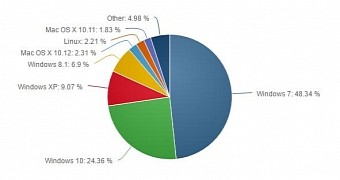Microsoft has been pushing hard for everyone to switch to Windows 10, but statistics provided by various third parties show that the world is not ready to give up on older operating systems just yet, and this is one of the reasons Windows 7 remains the world’s top choice on the desktop.
NetMarketShare data for the month of December 2016 shows that Windows 7 not only remains the leading operating system for PCs but it’s also increasing its market share. And what’s worse for Microsoft is that it grows at a faster pace than Windows 10.
Last month, Windows 7 remained the leading desktop operating system with a market share of 48.34 percent, followed by Windows 10 with 24.36 percent. Windows XP was third with 9.07 percent, while Windows 8.1 was next with 6.90 percent.
Specifically, Windows 10 improved its share from 23.72 percent in November to 24.36 percent in December, which means that it posted a growth of 0.64 percent. Windows 7, on the other hand, recorded an increase of 1.17 percent from 47.17 percent to 48.34 percent.
Slower upgrade pace
The results are particularly worrying for Microsoft especially because these stats were collected in December, a month when new device activations typically increase during Christmas.
If Microsoft wants to see the glass half full, then Windows 10 clearly keeps growing, although it’s very obvious that it does so at a slower pace than before. Windows 10 was launched in July 2015 and it experienced a huge boost in adoption trends from the very beginning thanks to the free upgrade offer aimed at Windows 7 and 8.1 users, but also due to what many described as a too aggressive upgrade campaign.
Now that Windows 10 is no longer offered free of charge, the pace at which users upgrade to the new OS has clearly slowed down, but the worst news for Microsoft comes from the Windows 7 front. At this point, Windows 7 should become Microsoft’s main concern, as the operating system will reach end of support in 2020 and there’s a good chance that millions of users will still be running it at that point.

 14 DAY TRIAL //
14 DAY TRIAL //